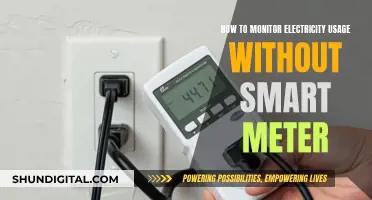
Monitoring electricity usage at home is essential for those who want to reduce their carbon footprint, lower their electricity bills, and improve their energy efficiency. In India, there are various tools and devices available to help homeowners track their energy consumption, such as the Emporia Vue Gen 2 Wireless Energy Monitor, which can help save up to 20% on monthly power bills, and the Sense Electricity Usage Monitor, which can be purchased online. These devices can provide real-time data on electricity usage and help identify appliances that are using the most energy, allowing homeowners to make informed decisions about their energy usage.
| Characteristics | Values |
|---|---|
| Purpose | To monitor electricity usage in the home |
| Benefits | Save money on energy bills, identify discrepancies in bills, identify potential issues with appliances, improve energy efficiency, lower carbon footprint |
| Devices | Sense Electricity Usage Monitor, Emporia Vue Gen 2 Wireless Energy Monitor, Schneider Electric's Wiser home energy optimisation system |
| Features | Smartphone app, easy installation, non-invasive, cloud data storage, alerts for high usage, real-time data |
| Cost | Sense Electricity Usage Monitor: ₹33,999.00; Emporia Vue Gen 2: Rs. 14,678.00-Rs. 32,900.00; Wiser: N/A |
What You'll Learn

Use a smart electricity monitor
Smart electricity monitors are an effective way to track your home's energy usage and save money on your electricity bills. Here are some benefits and features of using a smart electricity monitor:
Audit Your Electricity Bills
With a smart electricity monitor like the Emporia Vue Gen 2, you can analyse your electricity bills and compare them with your power usage data. This helps in identifying any discrepancies, such as overcharging, and allows you to resolve them.
Real-time Electricity Monitoring
Smart electricity monitors provide real-time data on your electricity usage. Devices like the Emporia Vue Gen2 can be installed in your electric panel or DP box, allowing you to access information from anywhere with an internet connection. This helps you track the electricity usage of individual appliances and identify which items are using the most energy.
Preventive Maintenance
By monitoring your electricity usage, you can identify potential issues with your appliances. For example, if an appliance is using significantly more electricity than usual, it may indicate a malfunction or the need for repair. Addressing these issues promptly can help prevent bigger problems and save on energy costs.
Set Up Alerts
Some smart electricity monitors, like the Emporia Vue Gen2, allow you to set up alerts on your smartphone app. You can be notified when your electricity usage exceeds a certain threshold, helping you stay on top of your energy consumption and take necessary actions.
Identify High-Energy Appliances
Smart electricity monitors can help you identify which appliances are using the most energy, even when they are in standby mode. This information can guide you in unplugging unnecessary devices and replacing old or inefficient appliances with energy-efficient models.
Compatibility with Smart Home Systems
Smart electricity monitors can be integrated with smart home systems, allowing you to control and monitor your energy usage through your smartphone or smart assistant devices like Alexa or Google Assistant. This enables you to operate appliances remotely and make energy-saving adjustments with ease.
Smart electricity monitors offer a convenient and detailed way to track your home's energy usage, providing you with valuable insights to make informed decisions and reduce your electricity costs.
Host Resource Monitor: Tracking Guest Memory Usage?
You may want to see also

Compare your power usage with your bills
Monitoring your electricity usage at home can be an effective way to keep a check on your bills. Here are some ways to compare your power usage with your electricity bills:
Understand Your Bill:
Firstly, it is important to understand the various components of your electricity bill. In India, electricity bills typically include the following:
- Meter Reading: This is the reading of your electricity consumption, usually recorded in kilowatt-hours (kWh). A representative from your electricity distribution company will come to your house and take this reading.
- Tariff Rates: These are set by the State Electricity Regulatory Commission and are based on factors such as the cost of generating and distributing electricity, fuel prices, and operational expenses. Tariff rates vary depending on the category of consumers, such as residential, commercial, or industrial.
- Energy Consumption Calculation: This is calculated by subtracting the previous meter reading from the current one and then multiplying the difference by the tariff rate per unit.
- Fixed Charges: Some distribution companies may also charge a fixed monthly fee, known as a service connection charge, regardless of your electricity consumption.
- Taxes and Other Charges: Finally, taxes and other charges such as meter rent, electricity duty, and surcharges are added to the bill. In India, a Goods and Services Tax (GST) of 5% is levied on electricity.
Calculate Your Usage:
Once you understand the components of your bill, you can start calculating your electricity usage. Here are some steps to help you:
- Assess Your Appliances: Identify all the appliances in your house and estimate their power ratings. Most power companies provide online calculators or tables to help you with this assessment.
- Check Your Bill: Look at your electricity bill and note the units consumed, whether you have a single-phase or three-phase connection, and the connected load or sanctioned load.
- Use an Online Calculator: Several websites offer online electricity bill calculators that can help you estimate your monthly energy consumption. These calculators will take into account factors such as your state, district, electricity distribution company, type of meter, and consumption.
- Monitor Specific Devices: If you want to get more specific, you can use electricity usage monitors or plug load monitors that can be purchased online or at hardware stores. These devices can be plugged into an outlet, and then you plug your appliance into the monitor. It will display the consumption in kilowatt-hours, helping you understand the cost of running each device.
- Compare Bills: A simple way to track your usage is by comparing your bills month-to-month. Look for any unusual spikes in consumption and try to identify the cause. This can help you pinpoint areas where you can save energy.
By following these steps, you can gain a better understanding of your power usage and make informed decisions to reduce your electricity bills. Remember that energy consumption is the primary factor in determining the cost of your electricity bill, so focus on identifying areas where you can conserve energy.
Monitoring Chrome's CPU Usage: Tab-Specific Performance Insights
You may want to see also

Identify appliances using the most energy
Monitoring your home's energy usage can help you identify specific issues that contribute to high electricity costs. While tracking the energy consumption of individual appliances can be tedious, it is worth the effort to better understand your energy consumption habits and take steps to lower your bills. Here are some tips to help you identify appliances that use the most energy:
- Estimate appliance usage: Determine how long each appliance runs daily. For devices like televisions or computers, this can be a rough estimate. For others, such as refrigerators, which typically run for up to eight hours a day, it may require some research. Alternatively, you can keep a logbook to record how long appliances like microwaves, ovens, or gaming consoles are used each time they are turned on.
- Determine maximum wattage: Find the maximum wattage of each appliance, usually indicated by a sticker on the appliance's backside or bottom, or in the owner's manual. If the manufacturer uses amperes (amps) instead, multiply the amps by the voltage (typically 120 volts for small appliances and 240 volts for larger ones) to estimate wattage.
- Calculate daily and annual energy consumption: Use the formula (Wattage x Hours Used per Day) / 1000 to calculate daily kilowatt-hour usage. To estimate annual consumption, multiply the daily kilowatt-hour usage by the number of days the appliance is used in a year.
- Invest in energy monitors: Consider purchasing an electricity usage monitor or energy monitor plugs to simplify the process. Whole-home energy monitors attach to your electrical panel and track overall energy consumption, while energy monitor plugs are plugged into individual appliances to calculate their daily, weekly, and yearly energy usage.
- Identify high-energy appliances: Appliances like central air conditioning units, washers, dryers, and electric heaters tend to use the most energy. Monitoring their usage can help you make informed decisions about replacing them with more energy-efficient models.
- Look for "vampire appliances": Some appliances continue to draw power even when they are turned off or in standby mode. These "vampire appliances" can contribute significantly to your energy bill. Unplugging them when not in use or using smart power strips can help reduce vampire energy consumption.
Monitoring Docker Container Resource Usage: A Comprehensive Guide
You may want to see also

Set up alerts for high electricity usage
Energy monitoring is a great way to keep track of your electricity usage and reduce energy costs. There are several smart electricity monitoring systems available in India that can help you monitor your electricity usage and set up alerts for high electricity consumption. Here are some options:
Emporia Vue Gen 2
Emporia Vue Gen 2 is a wireless energy monitor that can detect and measure all energy usage points and display the data on your mobile app. It consists of a device that attaches to your home's electric panel and a smartphone app. The device fits inside your existing DP box without any invasive wire cutting or rewiring. The app allows you to set up alerts that will notify you when your electricity usage exceeds a certain threshold. This can help you stay on top of your energy consumption and take action to reduce usage if needed.
Sense Electricity Usage Monitor
This monitor can be purchased on Amazon.in for ₹33,999.00. It has 4.1 out of 5 stars and over 2,000 ratings. The monitor can detect and measure your energy usage, helping you identify high-energy appliances and set up alerts for high electricity usage.
Schneider Electric India
Schneider Electric India offers smart energy monitoring solutions that allow you to monitor your energy use, set energy budgets, and provide real-time insights into your energy costs. Their Wiser home energy optimisation system helps you track your electrical consumption and charge your electrical vehicle battery faster.
By using these energy monitoring systems and setting up alerts for high electricity usage, you can stay informed about your energy consumption, identify areas where you can reduce usage, and save money on your energy bills.
Monitoring Resource Usage: Strategies for Optimal Performance
You may want to see also

Use energy-efficient appliances
One of the most effective ways to monitor and reduce electricity usage in the home is to use energy-efficient appliances. This involves replacing old or inefficient appliances with models that are designed to be more energy-efficient, such as those with an Energy Star certification.
Energy-efficient appliances are designed to use less electricity to perform the same functions as their less efficient counterparts. This reduction in electricity usage can lead to significant savings on energy bills over time. For example, an electric kettle with a wattage of 1500 W and used for about 1 hour per day will cost approximately $60.23 per year to operate. However, by replacing this kettle with a more efficient model, such as one with a lower wattage or improved insulation, the annual operating cost could be reduced.
In addition to purchasing Energy Star-certified appliances, there are other ways to practice energy efficiency at home. This includes turning off lights and appliances when not in use, using energy-efficient lighting, and investing in a smart home system to better control and monitor energy usage.
It is also important to note that many appliances continue to draw a small amount of stand-by power even when they are switched off. These "phantom loads" can occur in most appliances, including televisions, stereos, computers, and kitchen appliances. One way to avoid these phantom loads is to use a power strip and switch it off to cut all power to the appliance when it is not in use.
By combining the use of energy-efficient appliances with other energy-saving practices, individuals can significantly reduce their electricity usage and lower their energy costs.
Monitoring Data Usage on Your iPad: A Guide
You may want to see also
Frequently asked questions
A smart electricity monitor is a device that attaches to your home's electric panel and connects to a smartphone app, allowing you to track your electricity usage in real-time. It can help you identify which appliances are using the most energy and enable you to take steps to reduce your energy consumption and save money on your power bills.
You can use a system like the Emporia Vue Gen2, which includes split-core current transformers (CT) sensors that can be clamped onto phase lines or load circuits, providing detailed information on electricity usage in different parts of your home.
Monitoring your home's electricity usage can help you lower your electricity bills by identifying areas where you can reduce consumption. It also helps you actively reduce your carbon footprint and enables you to efficiently manage your energy usage, improving your home's sustainability.







